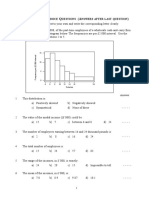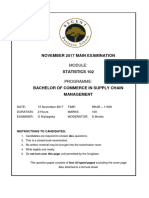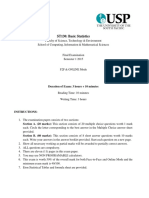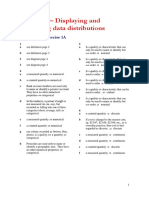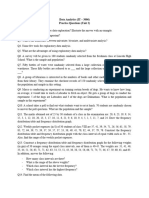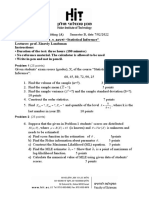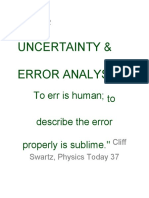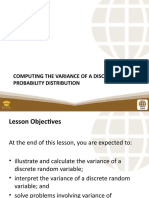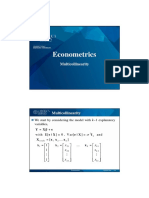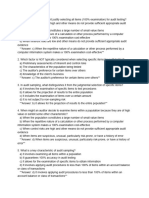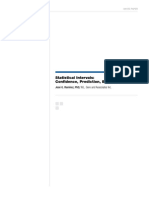STATISTICAL METHODS
EXERCISES: Tables and Graphs (Chapter 2)
Questions 1 to 3 are based on the following data:
The hourly number of complaints received at a call centre for last 22 working hours is as follows:
1 2 1 2 2 1 4 0 5 2 5 0 3 2 0 1 4 5 3 3 5 0
Question 1
Construct a complete frequency table. Use the components listed in the following table.
Value Frequency RF RF% CF CRF CRF%
Question 2
Construct a bar chart using the relative frequency percentage.
Question 3
Which one of the following statements is incorrect?
a) The variable has 6 possible values
b) Four of the randomly selected hours had no complaints
c) If X = the number of complaints received, then the relative frequency for the observed values
2 x 4 is equal to 0.454
d) Approximately 59% of the sampled hours recorded at most 2 complaints
Questions 4 and 5 are based on the following data:
The time (in minutes) spent in a check-out counter at Spar for a random sample of 30 customers are as follows:
5.1 5.4 5.8 6.0 6.0 6.3 6.4 7.0 7.0 7.3
7.5 7.6 8.1 8.1 8.3 8.4 8.5 8.7 8.7 8.7
8.9 9.0 9.2 9.3 9.5 9.7 9.7 10.1 10.3 10.7
Question 4
Construct a complete frequency table, where the first class interval is [5, 6). Use the components listed in the
following table.
Class Frequency RF RF% CF CRF CRF% MP
1
�Question 5
Construct a stem-and-leaf plot (using raw data), histogram (using RF), frequency polygon (using frequency)
and cumulative frequency polygon (using CRF%).
Question 6
The following frequency table describes the amount of petrol purchased (in litres) by 25 motorists at a
particular petrol station. Calculate the values for the missing cells in this table.
Petrol purchased (in litres) Frequency Relative frequency Cumulative frequency
30 x 35 2
35 x 40 0.24
40 x 45 9
45 x 50
Which one of the following statements is true?
a) Exactly 8 motorists purchased under 50 litres of petrol
b) 17 of the motorists purchased 40 litres or less
c) 32% of motorists purchased less than 40 litres of petrol
d) Only 0.36% of motorists purchased from 40 to just under 45 litres of petrol
e) A total of 8 motorists purchased more than 35 litres of petrol
Question 7
The marks (in percentage) for a statistics test, obtained by 852 students, are summarised as follows:
Interval Frequency Midpoint Relative Frequency Cumulative frequency
0 x 10 5
10 x 20 11 B
20 x 30 0.054
30 x 40
40 x 50
50 x 60 A
60 x 70
70 x 80
80 x 90 C
90 x 100 52
2
�The missing values indicated by A, B (to 3 decimal places) and C are:
a) A= 60 B=0.192 C=164
b) A= 55 B=0.013 C=800
c) A= 50 B=0.013 C=52
d) A= 55 B=0.011 C=852
e) A= 55 B=0.013 C=57
Questions 8 to 12 are based on the following:
In a competition to see who could hold their breath the longest, 40 children all took a deep breath and the times
(in seconds) it took for each to breathe again are summarised as follows.
Time (in seconds) recorded in a breath-holding competition
Class intervals Frequency RF CF CRF
[0.5, 5.5) 3
[5.5, 10.5) 7 E
[10.5, 15.5) 11
[15.5, 20.5) 10 A
[20.5, 25.5) 6 C
[25.5, 30.5) 3 B D F
Question 8
Find the missing values A, B, C, D, E and F.
Question 9
Which one of the following statements is incorrect?
a) 3 children could only hold their breath 5.5 seconds
b) 11 children could hold their breath between 10.5 and 15.5 seconds
c) A quarter of the children could hold their breath for less than 10.5 seconds
d) The midpoint for the last class interval is 28
Question 10
Describe the distribution in terms of symmetry and modality. Select all options that apply:
a) Approximately symmetric
b) Positively skewed
c) Negatively skewed
d) Unimodal
e) Bimodal
3
�Question 11
Select all the appropriate graphical methods that can be used to represent the data in the table.
a) Bar chart
b) Histogram
c) Frequency polygon
d) Ogive
Question 12
Consider the following four graphs and identify everything that is incorrect in its representation of the data.
Graph A
Graph B
Graph C
4
�Question 13
A survey of randomly selected homes recorded the number of cars registered to each household. The following
bar graphs represents the frequency distribution of the number of cars per household.
50 46
45
40
35 31
28
Frequency
30
25
20
15
15
10 8
5
0
0 1 2 3 4
Number of cars per household
Which one of the following statements is false?
a) A total of 128 households were surveyed
b) The households have at most 4 cars
c) Approximately 22% of households have no car
d) 77% of the household have 1 or 2 cars
Question 14
Consider the following graph for a continuous random variable X, where the first class interval is (0, 1].
Determine the shape of the distribution of X in terms of modality. Hint: use frequencies.
a) Unimodal
b) Bimodal
c) Multimodal
d) No mode (uniform)
5
�Question 15
A researcher is interested in evaluating the weight distribution of a product that was recently introduced in the
market. The following table summarises the weights (in grams) for a random sample of 30 items of the product.
Product weight Frequency
[63, 66) 2
[66, 69) 5
[69, 72) 9
[72, 75) 6
[75, 78) 5
[78, 81) 2
[81, 84) 1
Which one of the following graphs is correct in its representation of the product weight distribution given in
the table?
Graph A Graph B
10
9
81 63
78 8
66 7
75 6
5
4
3
72 69 2
1
0
63 66 69 72 75 78 81 84 87
Graph C Graph D
10 35
9
30
8
7 25
6
20
5
15
4
3 10
2
5
1
0 0
64.5 67.5 70.5 73.5 76.5 79.5 82.5 61.5 64.5 67.5 70.5 73.5 76.5 79.5 82.5
a) Graph A is correct
b) Graph B is correct
c) Graph C is correct
d) Graph D is correct
e) None of the graphs are correct
6
�Question 16
A toy manufacturer tested a sample of 20 boxes, each containing 5 toys, to determine how many in each box
were defective. The data are summarised in the following bar graph.
Consider the following statements and choose the correct alternative from a) to e) below.
I 35% of the sampled boxes contain more than two defective toys
II 43 of all the toys sampled were found to be defective
III The number of defectives is a numerical random variable
a) Only statement I is true
b) Only statement III is true
c) Only statements I and III are true
d) Only statements II and III are true
e) All three statements are true
Question 17
A sample of students who has taken a statistics test has a mean score of 78.2, a median of 67, and a mode
score of 60. Based on this information, the distribution of test scores is:
a) Symmetric
b) Right skewed
c) Left skewed
d) Bimodal
e) Bell shaped
7
�Question 18
Consider the following ogive on the daily activity of a sample of 200 students on Twitter. The first class
interval is (0, 10].
How many students sent more than 30 tweets per day?
a) 21
b) 34
c) 148
d) 166
e) 177
Question 19
The time taken to process documentation at a service counter at the bank for customers who were opening a
banking account for the first time were recorded. The first class interval is (0, 5].
Indicate whether the following statements are true or false.
a) Two customers took longer than 20 minutes for their documentation to be processed
b) It took longer than 15 minutes for twelve customers to be served
c) Twenty customers had their documentation processed within 16 minutes
8
�Question 20
A commercial property insurance company wishes to expand its products into Africa. As part of its assessment
of major risk factors that can cause property damage, they evaluate the risks of natural disasters throughout
Africa. Although Africa is less prone to earthquakes than other areas in the world, the company collects data
from the National Geophysical Data Centre on earthquake prevalence and magnitude in Africa from 1960 to
2012. The data for 40 earthquakes are summarised in the following histogram, where the first class interval
is [2.5, 3.5).
Which one of the following statements is true?
a) The distribution of this data is positively skewed
b) At least 40 earthquakes were recorded in this dataset
c) A total of 22 earthquakes register 5.5 or more on the scale
d) All of the above statements are false
SOLUTIONS
Question 1
Value Frequency RF RF% CF CRF CRF%
0 4 0.182 18.2 4 0.182 18.2
1 4 0.182 18.2 8 0.364 36.4
2 5 0.227 22.7 13 0.591 59.1
3 3 0.136 13.6 16 0.727 72.7
4 2 0.091 9.1 18 0.818 81.8
5 4 0.182 18.2 22 1 100
Total 22 1 100
9
�Question 2
Question 3
C
Question 4
Class Frequency RF RF% CF CRF CRF% MP
[5, 6) 3 0.1 10 3 0.1 10 5.5
[6, 7) 4 0.13 13 7 0.23 23 6.5
[7, 8) 5 0.17 17 12 0.4 40 7.5
[8, 9) 9 0.3 30 21 0.7 70 8.5
[9, 10) 6 0.2 20 27 0.9 90 9.5
[10, 11) 3 0.1 10 30 1 100 10.5
Total 30 1 100
Question 5
Stem Leaf (leaf unit = 0.1)
5 1 4 8
6 0 0 3 4
7 0 0 3 5 6
8 1 1 3 4 5 7 7 7 9
9 0 2 3 5 7 7
10 1 3 7
10
�Question 6
C
Petrol purchased (in litres) Frequency Relative frequency Cumulative frequency
30 x 35 2 0.08 2
35 x 40 6 0.24 8
40 x 45 9 0.36 17
45 x 50 8 0.32 25
Total 25 1
11
�Question 7
B
Question 8
A = 0.25
B =0.075
C = 37
D = 40
E = 0.25
F=1
Question 9
A
Question 10
A, D
Question 11
B, C, D
Question 12
Graph A
• The bar chart is not an appropriate graph to use for continuous data
Graph B
• The ogive is constructed by plotting the upper limits of the class intervals on the x-axis against the
required component on the y-axis, not the lower limits of the class intervals
• The label on the y-axis (CRF%) does not correspond with the y-values (CF)
Graph C
• The frequency polygon uses the midpoints of the class intervals on the x-axis, not the upper limits of
the class intervals
• There are no labels given for the x-axis and the y-axis
• The graph must be attached to the x-axis using the midpoints of two additional class intervals added
before and after the class intervals given in the table, corresponding to a frequency of 0
12
�Question 13
D
Question 14
B
Question 15
E
Question 16
E
Question 17
B
Question 18
B
Question 19
a) True
b) False
c) False
Question 20
C
13




















